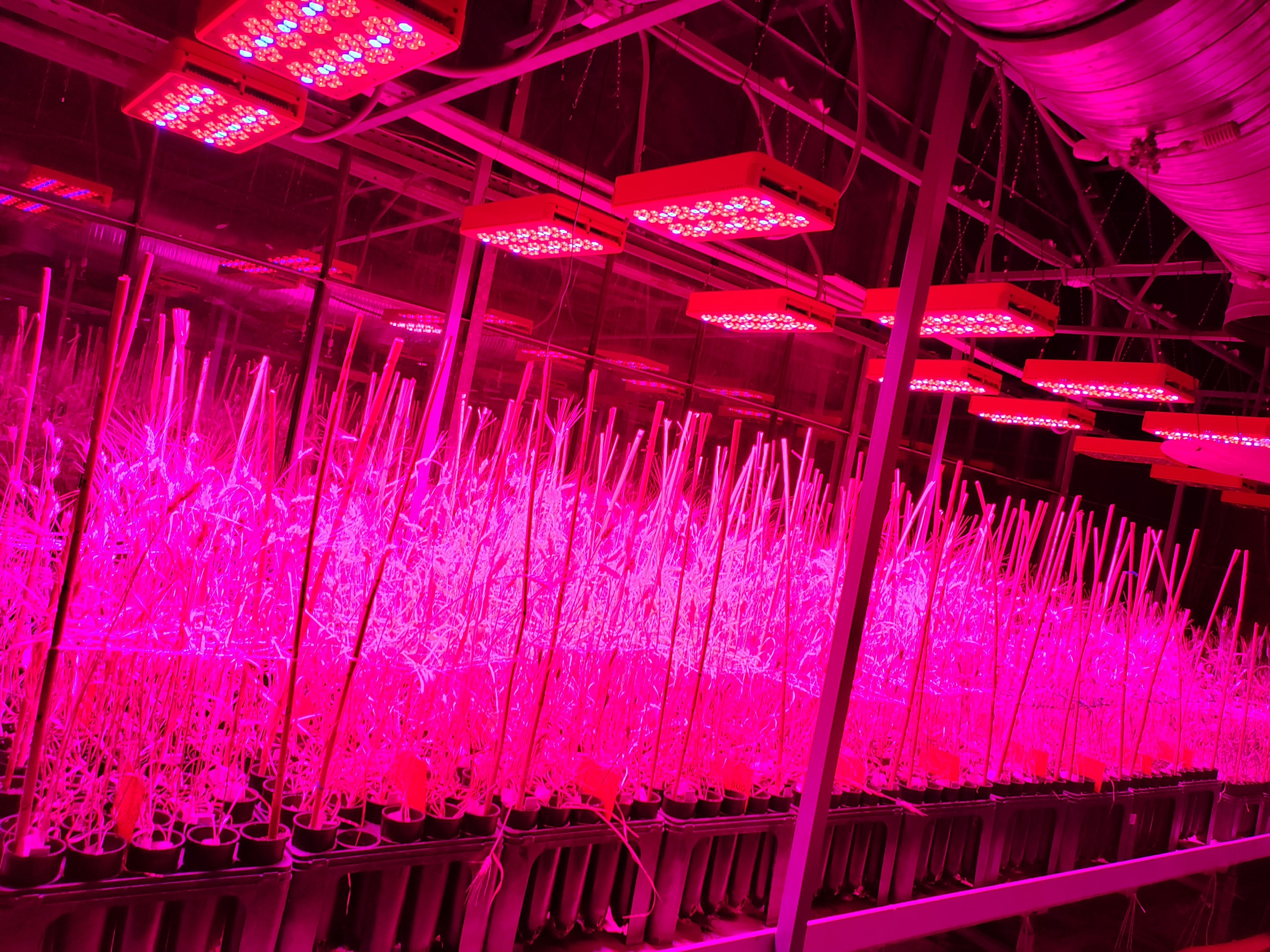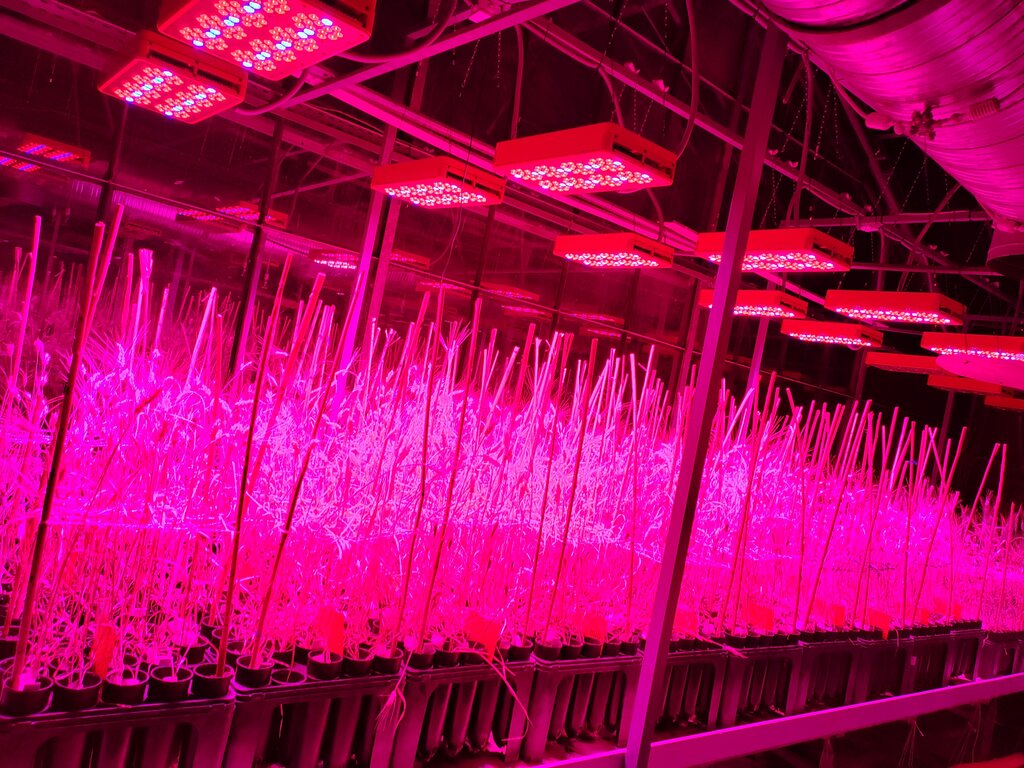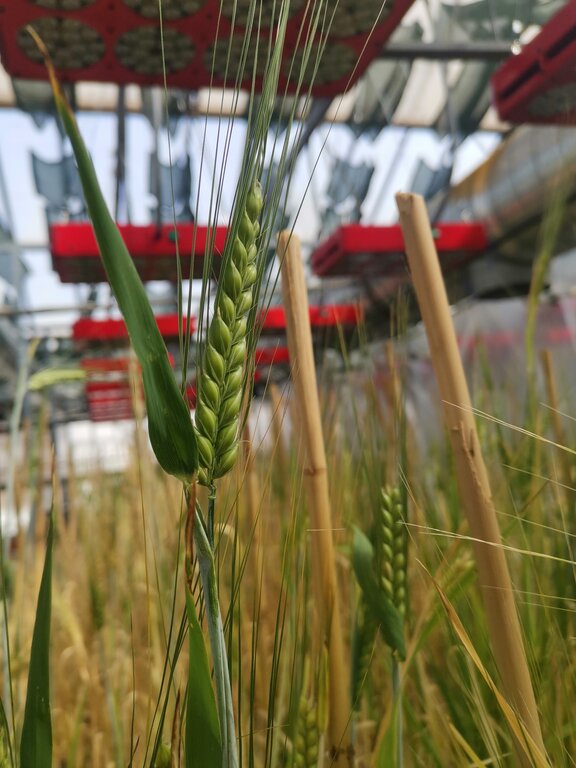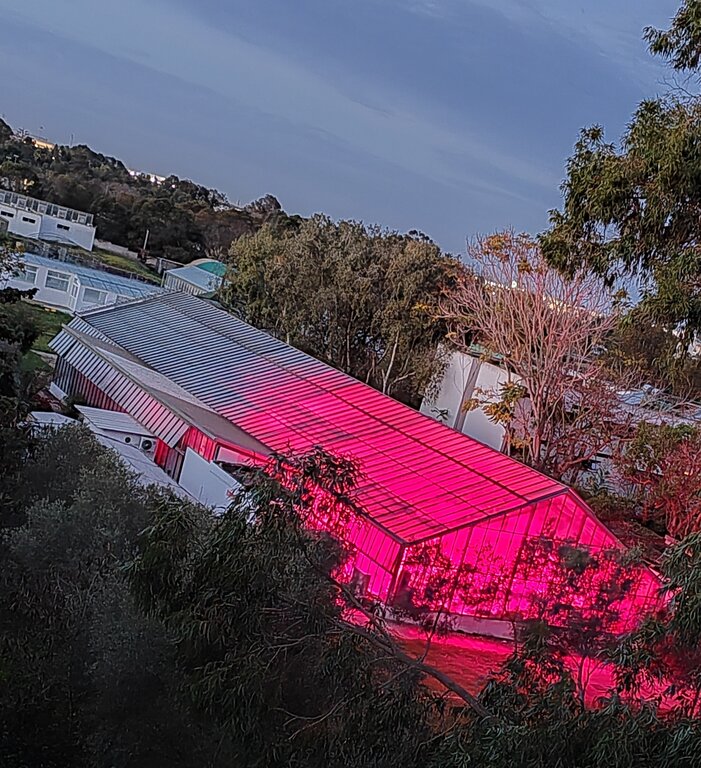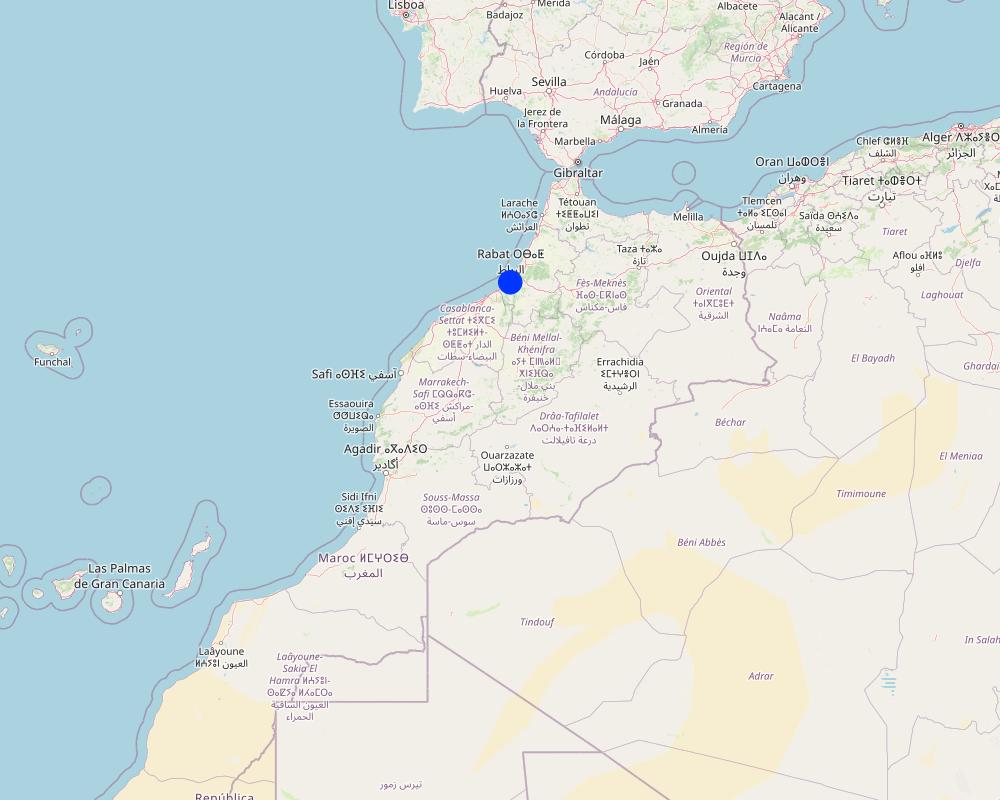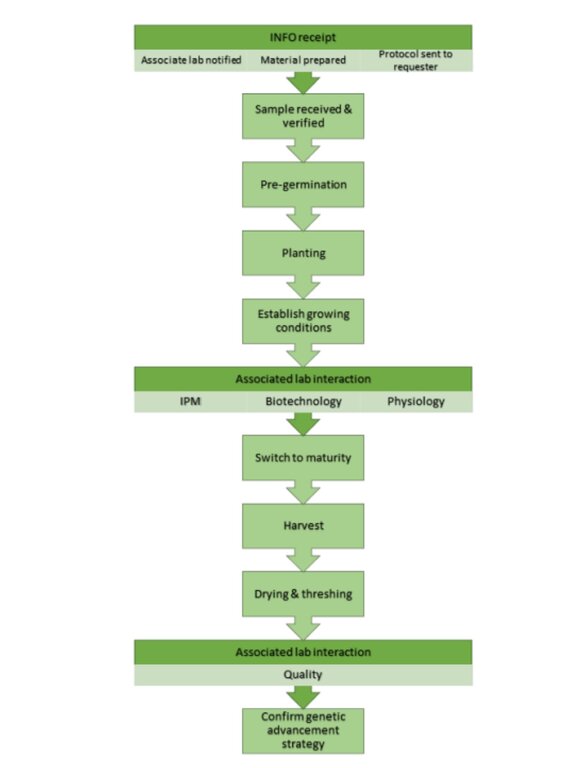Speed Breeding Platform [ມໍລອກໂກ]
- ການສ້າງ:
- ປັບປູງ:
- ຜູ້ສັງລວມຂໍ້ມູນ: Joren Verbist
- ບັນນາທິການ: –
- ຜູ້ທົບທວນຄືນ: William Critchley, Rima Mekdaschi Studer
approaches_6875 - ມໍລອກໂກ
ເບິ່ງພາກສ່ວນ
ຂະຫຍາຍທັງໝົດ ຍຸບທັງໝົດ1. ຂໍ້ມູນທົ່ວໄປ
1.2 ລາຍລະອຽດ ການຕິດຕໍ່ ຂອງບຸກຄົນທີ່ຊັບພະຍາກອນ ແລະ ສະຖາບັນ ການມີສ່ວນຮ່ວມ ໃນການປະເມີນຜົນ ແລະ ເອກະສານ ຂອງວິທີທາງ
ບຸກຄົນສຳຄັນ (ຫຼາຍຄົນ)
Developed the Standard Operating Procedures of ICARDA Speed Breeding Platform:
Zaim M
International Center of Agricultural Research in Dry Areas (ICARDA)
ມໍລອກໂກ
Speed Breeding Platform co-developer:
Morsli H
International Center of Agriculture Research in the Dry Areas (ICARDA)
ມໍລອກໂກ
Physiologist:
Visioni M
International Center of Agricultural Research in Dry Areas (ICARDA)
ມໍລອກໂກ
Entomologist:
Boulamtat R
International Center of Agricultural Research in Dry Areas (ICARDA)
ມໍລອກໂກ
Pathologist:
Kemal S.A.
ມໍລອກໂກ
Barley Breeder and Speed Breeding Platform designer:
Sanchez-Garcia M
International Center of Agricultural Research in Dry Areas (ICARDA)
ມໍລອກໂກ
ຊື່ຂອງໂຄງການ ທີ່ອໍານວຍຄວາມສະດວກ ໃນການສ້າງເອກກະສານ ຫຼື ປະເມີນດ້ານແນວທາງ (ຖ້າກ່ຽວຂ້ອງ)
ICARDA Institutional Knowledge Management Initiativeຊື່ຂອງ ສະຖາບັນການຈັດຕັ້ງ ທີ່ອໍານວຍຄວາມສະດວກ ໃນການສ້າງເອກກະສານ ຫຼື ປະເມີນແນວທາງ (ຖ້າກ່ຽວຂ້ອງ)
International Center for Agricultural Research in the Dry Areas (ICARDA) - ລີບານອນ1.3 ເງື່ອນໄຂ ຂອງການນໍາໃຊ້ເອກກະສານຂໍ້ມູນ ຂອງ WOCAT
ເມື່ອໃດທີ່ໄດ້ສັງລວມຂໍ້ມູນ (ຢູ່ພາກສະໜາມ)?
2022
ຜູ້ສັງລວມ ແລະ ບັນດາຜູ້ຕອບແບບສອບຖາມ ຍອມຮັບໃນເງື່ອນໄຂ ການນໍາໃຊ້ຂໍ້ມູນເອກະສານ ທີ່ສ້າງຂື້ນ ໂດຍຜ່ານ ອົງການ WOCAT:
ແມ່ນ
2. ພັນລະນາ ແນວທາງການຄຸ້ມຄອງນໍາໃຊ້ດິນແບບຍືນຍົງ
2.1 ການອະທິບາຍ ໂດຍຫຍໍ້ ຂອງວິທີທາງ
Improving crop varieties is crucial for food security and climate resilience, but traditional methods are slow and expensive. The Speed Breeding Platform shortens breeding time substantially, enhances quality, and relies on strong partnerships between NARES and CGIAR centers.
2.2 ການອະທິບາຍ ລາຍລະອຽດ ຂອງວິທີທາງ
ການອະທິບາຍ ລາຍລະອຽດ ຂອງວິທີທາງ:
Climate change presents significant challenges for agriculture and crop production. One possible solution to enhance climate resilience is the development and adoption of improved, better adapted crop varieties. These varieties are specifically engineered to withstand specific threats, offering farmers a more reliable means of ensuring successful harvests despite the challenges posed by a changing climate. Improved varieties are thus crucial for achieving food security.
However, a major limitation of this solution is that researching and producing new crop varieties is a complex process that demands considerable time and resources. It involves cross design, segregating generation advancement and rigorous field testing to identify traits. The development of new varieties often spans several years, if not decades, before they are ready for widespread adoption by farmers. Sustained investment and collaboration across scientific organizations are thus crucial.
To accelerate the development of improved crop varieties, the International Center of Agricultural Research in Dry Areas (ICARDA), together with partners is implementing Speed Breeding as its main generation advancement method. Through the support of the Arab Fund for Economic and Social development (AFESD), the Templeton World Charity Foundation, Inc and the Crop Trust, protocols to accelerate the generation advancement of the main crops (wheat, barley, faba bean, lentil, grasspea and chickpea) have been developed and are available to NARES. ICARDA has also established the Speed Breeding Platform in Rabat, Morocco. Covering approximately 500 square meters, this facility comprises four buildings, including two greenhouses of 175 m2 and 185 m2 respectively, each housing five independently controlled growth chamber.i
The Speed Breeding method utilises LED lighting - originally invented by NASA to sustain astronauts during prolonged space missions to compensate for the absence of sunlight in space. By providing plants with approximately 22 hours of light per day, this accelerates their growth significantly. Cultivating crops in a controlled environment shields them from the unpredictable impacts of adverse weather conditions. The major advantage is thus its ability to accelerate the breeding process for improved crop varieties. For instance, while traditional methods may take between 6 and 12 years to breed a new grass pea (Lathyrus sativus) variety, utilizing the Speed Breeding Platform reduces this timeframe to approximately 5 years. The Speed Breeding Platform thus enhances efficiency and responsiveness in addressing agricultural challenges.
The Speed Breeding Platform has a capacity for advancing over 50,000 cereal and legume plants. This is done in close collaborations with fellow scientists from other CGIAR centers and National Agricultural Research and Extensions Services (NARES) centers. NARES centers play an indispensable role in determining the traits and varieties to prioritize for advancement, using their direct engagement with farmers in field settings to assess their specific needs and challenges. The main advantages are:
- Varieties reach farmers faster by reducing the time from crossing to field testing;
- Testing during advancement increases the resilience of new varieties to pests and diseases i.e., higher quality of improved varieties;
- It can help coordinating breeding action between CGIAR and NARES by co-designing crosses and centralizing advancement i.e., higher resource efficiency.
The main disadvantage is the high costs associated with building and operating the facilities of the Platform. In addition, it requires expertise to operate. However, NARES personnel are currently being trained and educated in breeding and using the Speed Breeding Platform.
In conclusion, while improved crop varieties hold immense potential for climate resilience in agriculture and ensuring food security, their development remains a complex, time-consuming and resource-intensive process. The approach of the Speed Breeding Platform represents a promising step forward, by faster and more efficient crop breeding, facilitating a prompter solution.
Acknowledgement: the pilot facilities used to set up the ICARDA Speed Breeding Platform were funded by a project from the Third Call for Proposals under the Benefit-sharing Fund of the International Plant Treat for Plant Genetic Resources for Food and Agriculture entitled “Addressing the challenges of climate change for sustainable food security in Turkey, Iran and Morocco, through the creation and dissemination of an international database to promote the use of wheat genetic resources and increase genetic gains.” CFP 2014/2015-W3B-PR-18-Turkey. The final facilities were funded by a project from the Arab Fund for Economic and Social Development (AFESD) entitled “Modernization of ICARDA Breeding Programs".
2.3 ຮູບພາບຂອງແນວທາງ
2.5 ປະເທດ / ເຂດ / ສະຖານທີ່ບ່ອນທີ່ແນວທາງໄດ້ຖືກນໍາໃຊ້
ປະເທດ:
ມໍລອກໂກ
ຂໍ້ມູນເພີ່ມເຕີມຂອງສະຖານທີ່:
Rabat
Map
×2.6 ວັນທີເລີ່ມຕົ້ນ ແລະ ສິ້ນສຸດ ການຈັດຕັ້ງປະຕີບັດ ວິທີທາງ
ສະແດງປີຂອງການເລີ່ມຕົ້ນ:
2021
2.7 ປະເພດຂອງແນວທາງ
- ພາຍໃຕ້ໂຄງການ / ແຜນງານ
2.8 ເປົ້າໝາຍ / ຈຸດປະສົງຫຼັກ ຂອງການຈັດຕັ້ງປະຕິບັດ ວິທີທາງ
The objective of the new Speed Breeding Platform is to provide the tools to CGIAR and NARES breeding programs to develop better varieties faster and shorten the time needed to reach farmer’s fields. The access to this technology also helps responding to new threats hindering productivity in a faster and more effective way.
2.9 ເງື່ອນໄຂອໍານວຍ ຫຼື ຂັດຂວາງການປະຕິບັດຂອງເຕັກໂນໂລຢີ / ເຕັກໂນໂລຢີການນໍາໃຊ້ຕາມແນວທາງ
ມີຄວາມສາມາດ / ເຂັ້າເຖິງຊັບພະຍາກອນດ້ານການເງິນ ແລະ ການບໍລິການ
- ເຊື່ອງຊ້ອນ
Developing this type of facilities require an important initial investment and more importantly a considerable running cost.
ການກໍ່ຕັ້ງສະຖາບັນ
- ອໍານວຍ
The leading institution, in this case ICARDA, realized the potential for impact of this technology for the region and initiated the fund raising to make it happen.
ການຮ່ວມມື / ການປະສານງານຂອງຜູ້ກ່ຽວຂ້ອງ
- ອໍານວຍ
The use of this technology will involve the coordination between ICARDA Speed Breeding Platform personnel, ICARDA breeders and NARES breeders to decide the best approach to have a collaborative use of the facilities.
ຄວາມຮູ້ກ່ຽວກັບການຄຸ້ມຄອງ ທີ່ດິນແບບຍືນຍົງ, ການເຂົ້າເຖິງການສະໜັບສະໜູນ ທາງດ້ານວິຊາການ
- ເຊື່ອງຊ້ອນ
This technology requires not only the adequate facilities but also the know-how. ICARDA has developed a Standard Operations Procedure that summarizes the know-how and it is freely available as international public good.
ວຽກ, ມີກໍາລັງຄົນ
- ເຊື່ອງຊ້ອນ
The use of the technology requires well trained manpower to effectively achieve a high number of generations per year.
3. ການມີສ່ວນຮ່ວມ ແລະ ບົດບາດຂອງພາກສ່ວນທີ່ກ່ຽວຂ້ອງທີ່ໄດ້ມີສ່ວນຮ່ວມ
3.1 ຜູ້ມີສ່ວນຮ່ວມ ໃນວິທີທາງ ແລະ ພາລະບົດບາດ ຂອງເຂົາເຈົ້າ
- ນັກຄົ້ນຄວ້າ
CGIAR, ICARDA, and NARES breeders
They decide the plant populations to be advanced and the type of testing involved.
- ອົງການຈັດຕັ້ງ ສາກົນ
AFESD and FAO
The Benefit Sharing fund of the ITPGR (FAO) funded the growth chamber that was later used as pilot chamber to adapt and test the technology. Then, AFESD through the Breeding Modernization of ICARDA Breeding Programs provided the funds to build the new facilities.
ຖ້າຫາກມີຫຼາຍພາກສ່ວນທີ່ເຂົ້າຮ່ວມ ໃຫ້ລະບຸ ອົງການທີ່ເປັນຫຼັກ ໃນການຈັດຕັ້ງປະຕິບັດ:
ICARDA
3.2 ການມີສ່ວນຮ່ວມຂອງຜູ້ນໍາໃຊ້ທີ່ດິນໃນທ້ອງຖິ່ນ / ຊຸມຊົນທ້ອງຖິ່ນໃນໄລຍະທີ່ແຕກຕ່າງກັນຂອງແນວທາງ
| ການລວບລວມ ເອົາຜູ້ນໍາໃຊ້ດິນ ໃນທ້ອງຖິ່ນ / ຊຸມຊົນທ້ອງຖິ່ນ | ໃຫ້ລະບຸ ຜູ້ໃດທີ່ມີສ່ວນຮ່ວມ ໃນແຕ່ລະກິດຈະກໍາ? | |
|---|---|---|
| ການເລີ່ມຕົ້ນ / ແຮງຈູງໃຈ | ການບໍ່ປະຕິບັດ | |
| ການວາງແຜນ | ການບໍ່ປະຕິບັດ | |
| ການປະຕິບັດ | ການບໍ່ປະຕິບັດ | |
| ຕິດຕາມກວດກາ / ການປະເມີນຜົນ | ການບໍ່ປະຕິບັດ |
3.3 ແຜນວາດ (ຖ້າມີ)
ການອະທິບາຍ:
1: Receive information from requester (including material description, advancing strategy, traits, germplasm)
2: Receive and check samples: ICARDA Speed Breeding Platform staff inspect the samples prior to placing them in ICARDA Speed Breeding Platform Store 1 to identify and
address potential pests and other problems. Then, the samples are kept at -20°C for 24h to eliminate potential insect pests in the seeds.
3: Pre-germination: seeds are placed on the trays with systematic labeling. The results of pre-germination process are reported to the requester.
4: Growing conditions: The establishment of the growing conditions will depend on the crop and type of selection strategy applied.
5: Planting and transfer to growth room: Once the scientist confirms the planting list, the staff start planting on cones following the agreed protocol.
6: Trait collection: the facility manager will notify one week in advance the concerned labs when the plants are reaching the key growing stage set in the Project Protocol for trait recording or leaf sampling. Before maturity, the relevant disciplines are IPM, physiology and biotechnology. For traceability and data safety, data are recorded via Fieldbook Android Application, to be imported to BMS via BrApi.
7: Switch to maturity mode : After flowering the plants will enter the accelerated maturity process as per the protocols. Thus, the irrigation is stopped to force plant maturity. The requester will be notified of the entries with missing spikes or pods. At this stage, the FM will inform the quality lab to prepare for the reception of samples if established in the Project Protocol.
8. Harvest: The ICARDA Speed Breeding Platform staff harvest the plants following the requester selection (if any). The harvested spikes/pods are put in labeled bags showing: Crop, trial name, harvesting date, entry code and the barcode.
9. Drying and threshing: The harvested plants are placed in ovens for 2 days at 45°C, then threshed. If the Project Protocol includes it, the seeds are sent to the quality lab for end-use quality analysis. Otherwise, the seeds are kept in Store 1 for short term storage. The facility manager communicates the seed number of each entry to the requester, together with all recorded data.
10. Generation advancement strategy: Based on the data collected during the experiment, the requester confirms the next step of the genetic advancement strategy. In case a selection is made, the requester provides the required information by adding the information to the request form and send it to the RS to generate a new Project Protocol.
ຜູ້ຂຽນ:
ICARDA Cereals and Legumes Speed Breeding Platform ( https://hdl.handle.net/20.500.11766/67537 )
3.4 ການຕັດສິນໃຈກ່ຽວກັບການຄັດເລືອກເຕັກໂນໂລຢີຂອງການຄຸ້ມຄອງທີ່ດິນແບບຍືນຍົງ / ເຕັກໂນໂລຢີ
ລະບຸ ຄົນທີ່ຕັດສິນໃຈ ກ່ຽວກັບການຄັດເລືອກຂອງ ເຕັກໂນໂລຢີ / ເຕັກໂນໂລຢີ ຈະໄດ້ຮັບການປະຕິບັດ:
- ຊຽ່ວຊານ ສະເພາະດ້ານການຄຸ້ມຄອງ ດິນແບບຍືນຍົງຜູ້ດຽວ
Specify on what basis decisions were made:
- ຜົນທີ່ໄດ້ຮັບ ຈາກການຄົ້ນຄວ້າ
4. ການສະໜັບສະໜູນທາງດ້ານວິຊາການ, ການສ້າງຄວາມສາມາດ, ແລະ ການຈັດການຄວາມຮູ້.
4.1 ການສ້າງຄວາມສາມາດ / ການຝຶກອົບຮົມ
ຜູ້ນໍາໃຊ້ທີ່ດິນ ຫຼື ພາກສ່ວນກ່ຽວຂ້ອງອື່ນໆ ໄດ້ຮັບການຝຶກອົບຮົມບໍ່?
ແມ່ນ
- Researchers and breeders
ຮູບແບບຂອງການຝຶກອົບຮົມ:
- ການເຮັດຕົວຈິງ
- ຫຼັກສູດ
ໃນຫົວຂໍ້:
Breeding
4.2 ການບໍລິການໃຫ້ຄໍາປຶກສາ
ເຮັດຜູ້ໃຊ້ທີ່ດິນມີການເຂົ້າເຖິງການບໍລິການໃຫ້ຄໍາປຶກສາ?
ແມ່ນ
ລະບຸວ່າການສະໜອງ ການບໍລິການ ໃຫ້ຄໍາປຶກສາ:
- ໃນພື້ນທີ່ຂອງຜູ້ນໍາໃຊ້ດິນ
- ສູນຄົ້ນຄວ້າ
4.3 ສະຖາບັນການສ້າງຄວາມເຂັ້ມແຂງ (ການພັດທະນາອົງການຈັດຕັ້ງ)
ສະຖາບັນ ໄດ້ຮັບການສ້າງຕັ້ງຂື້ນ ຫຼື ໄດ້ຮັບການສ້າງຄວາມເຂັ້ມແຂງ ໂດຍການຈັດຕັ້ງປະຕິບັດ ວິທີທາງບໍ່?
- ມີ, ໜ້ອຍໜຶ່ງ
ລະບຸ ທາງສະຖາບັນ ໄດ້ສ້າງຄວາມເຂັ້ມແຂງ ໃນລະດັບໃດ (ຫຼາຍ):
- ແຫ່ງຊາດ
ລະບຸ ປະເພດ ຂອງສະໜັບສະໜູນ:
- ການສ້າງຄວາມອາດສາມາດ / ການຝຶກອົບຮົມ
ໃຫ້ລາຍລະອຽດເພີ່ມເຕີມ:
National scientists are trained in breeding and using the Speed Breeding Platform
4.4 ຕິດຕາມກວດກາ ແລະ ປະເມີນຜົນ
ການຈັດຕັ້ງປະຕິບັດ ວິທີທາງ ໄດ້ມີການປະເມີນຜົນ ແລະ ຕິດຕາມບໍ?
ບໍ່ແມ່ນ
4.5 ການຄົ້ນຄວ້າ
ນີ້້ແມ່ນສ່ວນໜຶ່ງ ການຄົ້ນຄວ້າ ຂອງວິທີທາງບໍ່?
ແມ່ນ
- Genetics / Breeding
ໃຫ້ຂໍ້ມູນ ເພີ່ມເຕີມ ແລະ ກໍານົດ ຜູ້ໃດເຮັດການຄົ້ນຄວ້າ:
Research in breeding is done by ICARDA, CGIAR centers and NARES centers
5. ການສະໜັບສະໜູນທາງດ້ານການເງິນ ແລະ ອຸປະກອນຈາກພາຍນອກ
5.1 ງົບປະມານປະຈໍາປີ ສໍາລັບວິທີທາງ ຂອງການຄຸ້ມຄອງ ທີ່ດິນແບບຍືນຍົງ
ຖ້າຫາກບໍ່ຮູ້ຈັດງົບປະມານທີ່ແນ່ນອນ ແມ່ນໃຫ້ປະມານເອົາ:
- 100,000-1,000,000
ຄໍາເຫັນ (ຕົວຢ່າງ: ແຫຼ່ງຂໍ້ມູນຫຼັກ ຂອງການສະໜອງທຶນ / ຜູ້ໃຫ້ທຶນທີ່ສໍາຄັນ):
The main donors were the Benefit Sharing Fund of the ITPGR (FAO) that provided the funding that resulted in the first Speed Breeding pilot facility with capacity for 3,000 plants and the Arab Fund for Economic and Social Development (AFESD) who provided the funds for the expansion of this initial pilot facility and develop the ICARDA Speed Breeding Platform, a fully automatic facility that allows advancing more than 50,000 cereal and legume plants
5.2 ການສະໜັບສະໜູນ ທາງດ້ານການເງິນ / ອຸປະກອນ ສະໜອງໃຫ້ແກ່ຜູ້ນໍາທີ່ດິນ
ຜູ້ນໍາໃຊ້ດິນ ໄດ້ຮັບການສະໜັບສະໜູນ ທາງດ້ານ ການເງິນ / ອຸປະກອນ ໃນການຈັດຕັ້ງປະຕິບັດ ເຕັກໂນໂລຢີບໍ?
ບໍ່ແມ່ນ
5.3 ເງິນສົມທົບສໍາລັບການນໍາໃຊ້ສະເພາະປັດໃຈຂາເຂົ້າໃນການຜະລີດກະສິກໍາ (ລວມທັງແຮງງານ)
- ບໍ່ມີ
5.4 ສິນເຊື່ອ
ໄດ້ປ່ອຍສິນເຊື່ອ ສະໜອງໃຫ້ພາຍໃຕ້ ວິທີການສໍາລັບກິດຈະກໍາ ການຄຸ້ມຄອງ ທີ່ດິນແບບຍືນນຍົງບໍ່?
ບໍ່ແມ່ນ
5.5 ສິ່ງຈູງໃຈ ຫຼື ເຄື່ອງມືອື່ນໆ
ການສົ່ງເສີມ ຈັດຕັ້ງປະຕິບັດ ເຕັກໂນໂລຢີ ໃນການຄຸ້ມຄອງ ດິນແບບຍືນຍົງ ໄດ້ສະໜອງສິ່ງກະຕຸກຊຸກຍູ້ບໍ່?
ບໍ່ແມ່ນ
6. ວິເຄາະຜົນກະທົບ ແລະ ສັງລວມບັນຫາ
6.1 ຜົນກະທົບຂອງແນວທາງ
ການຈັດຕັ້ງປະຕິບັດ ວິທີທາງ ສາມາດຊ່ວຍຜູ້ນໍາໃຊ້ທີ່ດິນ ໃນການຈັດຕັ້ງປະຕິບັດ ແລະ ບໍາລຸງຮັກສາ ເຕັກໂນໂລຢີ ການຄຸ້ມຄອງ ທີ່ດິນແບບຍືນຍົງໄດ້ບໍ?
- ບໍ່
- ມີ, ໜ້ອຍໜຶ່ງ
- ມີ, ພໍສົມຄວນ
- ມີ, ຫຼາຍ
Through the Speed Breeding Platform, improved varieties are publicly released to farmers and seed cooperation. This allows them to use their land more sustainable.
ການນໍາໃຊ້ ວິທີທາງ ສາມາດປັບປຸງ ການປະສານງານ ແລະ ຄ່າໃຊ້ຈ່າຍ ການຈັດຕັ້ງປະຕິບັດ ທີ່ມີປະສິດທິພາບ ຂອງການຄຸ້ມຄອງ ທີ່ດິນແບບຍືດຍົງໄດ້ບໍ່?
- ບໍ່
- ມີ, ໜ້ອຍໜຶ່ງ
- ມີ, ພໍສົມຄວນ
- ມີ, ຫຼາຍ
Building on strong collaboration between international partners and national partners, breeding became more centralized making it more cost-effective. The reduced breeding time also contributes to higher resource efficiency.
ການນໍາໃຊ້ ວິທີທາງ ສາມາດປັບປຸງຄວາມຮູ້ ແລະ ຄວາມສາມາດ ຂອງພາກສ່ວນທີ່ກ່ຽວຂ້ອງໄດ້ບໍ່?
- ບໍ່
- ມີ, ໜ້ອຍໜຶ່ງ
- ມີ, ພໍສົມຄວນ
- ມີ, ຫຼາຍ
Staff of NARES centers are trained in breeding.
ການນໍາໃຊ້ ວິທີທາງ ສາມາດສ້າງຄວາມເຂັ້ມແຂງ ໃຫ້ສະຖາບັນການຈັດຕັ້ງ, ການຮ່ວມມື ລະຫວ່າງພາກສ່ວນທີ່ກ່ຽວຂ້ອງບໍ່?
- ບໍ່
- ມີ, ໜ້ອຍໜຶ່ງ
- ມີ, ພໍສົມຄວນ
- ມີ, ຫຼາຍ
Staff of NARES centers are trained in breeding.
ການນໍາໃຊ້ ວິທີທາງ ໄດ້ປັບປຸງ ການຄໍ້າປະກັນສະບຽງອາຫານ ຫຼື ປັບປຸງໂຄສະນາການໄດ້ບໍ່?
- ບໍ່
- ມີ, ໜ້ອຍໜຶ່ງ
- ມີ, ພໍສົມຄວນ
- ມີ, ຫຼາຍ
Improved varieties are more climate resilient contributing to food security.
ການຈັດຕັ້ງປະຕິບັດ ວິທີທາງ ສາມາດສ້າງຄວາມອາດສາມາດໃຫ້ຜູ້ນໍາໃຊ້ດິນ ໃນການປັບຕົວ ຕໍ່ການປ່ຽນແປງດິນຟ້າອາກາດ / ຫຼດຜ່ອນຄວາມສ່ຽງທາງໄພພິບັດໄດ້ບໍ? :
- ບໍ່
- ມີ, ໜ້ອຍໜຶ່ງ
- ມີ, ພໍສົມຄວນ
- ມີ, ຫຼາຍ
Improved varieties are better adapted to the changing climate.
6.2 ແຮງຈູງໃຈຫຼັກຂອງຜູ້ນໍາໃຊ້ທີ່ດິນໃນການປະຕິບັດການຄຸ້ມຄອງທີ່ດິນແບບຍືນຍົງ
- ການຜະລິດເພີ່ມຂຶ້ນ
- ກໍາໄລເພີ່ມຂຶ້ນ (ຄວາມສາມາດ), ການປັບປຸງຄ່າໃຊ້ຈ່າຍ, ຜົນປະໂຫຍດ, ອັດຕາສ່ວນ
- ຫຼຸດຜ່ອນຄວາມສ່ຽງຂອງໄພພິບັດ
6.3 ຄວາມຍືນຍົງຂອງກິດຈະກໍາວິທີທາງ
ຜູ້ນໍາໃຊ້ ທີ່ດິນ ສາມາດສືບຕໍ່ ການຈັດຕັ້ງປະຕິບັດ ຜ່ານວິທີທາງໄດ້ບໍ່ (ໂດຍປາດສະຈາກ ການຊ່ວຍເຫຼືອ ຈາກພາກສ່ວນພາຍນອກ)?
- ບໍ່ແນ່ນອນ
6.4 ຈຸດແຂງ / ຂໍ້ດີ ຂອງວິທີທາງ
| ຈຸດແຂງ / ຂໍ້ດີ / ໂອກາດໃນການນໍາໃຊ້ທີ່ດິນ |
|---|
| Varieties reach farmers faster by reducing the time from crossing to field testing |
| Allows testing during advancement increasing the resilience of new varieties to pests and diseases |
| Can help coordinating breeding action between CGIAR and NARES by co-designing crosses and centralizing advancement |
6.5 ຈຸດອ່ອນ / ຂໍ້ເສຍຂອງແນວທາງ ແລະ ວິທີການແກ້ໄຂໃຫ້ເຂົາເຈົ້າ
| ຈຸດອ່ອນ / ຂໍ້ເສຍ / ຄວາມສ່ຽງໃນມູມມອງຂອງຜູ້ນໍາໃຊ້ທີ່ດິນ | ມີວິທີການແກ້ໄຂຄືແນວໃດ? |
|---|---|
| Relatively high initial investment to develop the facilities | ICARDA platform is open to NARES and other collaborators hence costs can be shared. |
| Expertise is needed to achieve results | Code of conducts and protocols of the facilities has been published and trainings of NARES staff are being done. |
7. ເອກກະສານອ້າງອີງ ແລະ ຂໍ້ມູນການເຊື່ອມໂຍງ
7.1 ວິທີການ / ແຫຼ່ງຂໍ້ມູນ
- ສໍາພາດ ຊ່ຽວຊານ ການຄຸ້ມຄອງ ດິນແບບຍືນຍົງ
- ການລວບລວມ ບົດລາຍງານ ແລະ ເອກະສານອື່ນໆ ທີ່ມີຢູ່ແລ້ວ
7.3 ການເຊື່ອມຕໍ່ກັບຂໍ້ມູນທີ່ກ່ຽວຂ້ອງທີ່ສາມາດໃຊ້ອອນໄລນ໌
ຫົວຂໍ້ / ພັນລະນາ:
ICARDA Cereals and Legumes Speed Breeding Platform.
URL:
https://mel.cgiar.org/reporting/downloadmelspace/hash/186eb1d94780ca956e9b86227305761a/v/7ec567b72097f21057ea41b0124cf1a7
ຫົວຂໍ້ / ພັນລະນາ:
Laura Becker, Enrico Bonaiuti, Miguel Sanchez-Garcia, Zakaria Kehel, Andrea Visioni, Ajit Govind. (1/12/2020). Monitoring, Evaluation, and Learning Plan for Modernization of Crop Breeding Programs in Arab Countries.
URL:
https://hdl.handle.net/20.500.11766/12212
ຫົວຂໍ້ / ພັນລະນາ:
Miguel Sanchez-Garcia, Zewdie Bishaw, Abdoul Aziz Niane. (31/12/2021). 2022 ICARDA global barley breeding program International Nurseries. Beirut, Lebanon: International Center for Agricultural Research in the Dry Areas (ICARDA).
URL:
https://hdl.handle.net/20.500.11766/66860
ຫົວຂໍ້ / ພັນລະນາ:
Samira El-Hanafi, Souad Cherkaoui, Zakaria Kehel, Miguel Sanchez-Garcia, Jean-Benoit Sarazin, P. Stephen Baenziger, Wuletaw Tadesse. (14/2/2022). Hybrid Seed Set in Relation with Male Floral Traits, Estimation of Heterosis and Combining Abilities for Yield and Its Components in Wheat (Triticum aestivum L. ). Plants, 11 (4).
URL:
https://hdl.handle.net/20.500.11766/67050
ຂໍ້ມູນການເຊື່ອມຕໍ່ ແລະ ເນື້ອໃນ
ຂະຫຍາຍທັງໝົດ ຍຸບທັງໝົດການເຊື່ອມຕໍ່
ບໍ່ມີຂໍ້ມູນການເຊື່ອມຕໍ່
ເນື້ອໃນ
ບໍ່ມີເນື້ອໃນ


